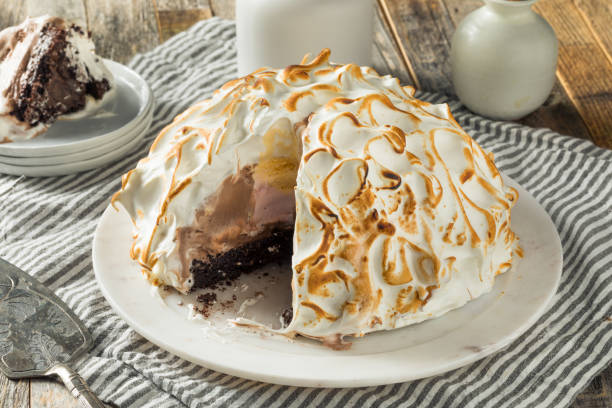Baked Alaska, a classic dessert that captivates both the eye and the palate, is a delightful combination of cake, ice cream, and meringue, all baked to perfection. This dish not only embodies a playful contrast of textures and temperatures but also carries with it a rich history that reflects its evolution through culinary traditions. To understand Baked Alaska fully, we must delve into its origins, preparation methods, variations, and cultural significance.
A Historical Perspective
The origins of Baked Alaska can be traced back to the mid-19th century. The dish is believed to have been inspired by the culinary creations of French chefs who were experimenting with frozen desserts and the innovative use of meringue. However, it was not until the 1860s that Baked Alaska, in its recognizable form, began to take shape.
The dish is often attributed to the renowned French pastry chef Charles Ranhofer, who worked at Delmonico’s Restaurant in New York City. In 1876, he created the dessert to celebrate the purchase of Alaska from Russia, hence the name “Baked Alaska.” The dish’s unique combination of flavors and the theatrical presentation of hot and cold components made it an instant hit among diners.
Components of Baked Alaska
At its core, Baked Alaska consists of three primary components: a base of cake, a layer of ice cream, and a fluffy meringue. The cake, often sponge or pound cake, serves as a sturdy foundation, providing structure to the dessert. The ice cream layer, which can be made from various flavors, is usually placed on top of the cake, creating a harmonious blend of textures. The meringue, whipped to soft peaks with sugar and sometimes a hint of vanilla, envelops the cake and ice cream, creating a protective barrier that allows for baking without melting the ice cream inside.
The Art of Preparation
The process of making Baked Alaska involves several steps, each requiring careful attention to detail. First, the cake is baked and allowed to cool completely. This step is crucial, as any residual heat could compromise the integrity of the ice cream layer. Once the cake has cooled, the ice cream is molded and placed on top. Many home cooks choose to soften the ice cream slightly before molding, making it easier to shape. This step can be achieved by leaving the ice cream out for a few minutes or gently stirring it until it reaches a more malleable consistency.
Crafting the Perfect Meringue
After the ice cream has been added, the meringue is prepared. The key to achieving the perfect meringue lies in the whipping technique. Egg whites must be beaten until they reach soft peaks, which indicates that they have incorporated enough air to achieve a light and fluffy texture. Gradually adding sugar while continuing to whip the mixture will stabilize the meringue and give it a glossy finish. Once the meringue is ready, it is spread generously over the ice cream and cake, ensuring that there are no gaps or openings that could allow heat to escape.
Baking: Where the Magic Happens
The next step is where the magic happens: baking. Baked Alaska is typically baked in a hot oven for a short period, usually around 5 to 10 minutes, depending on the recipe and the oven’s temperature. The goal is to achieve a beautifully browned meringue while keeping the ice cream inside frozen. This juxtaposition of temperatures creates a sensory experience that delights the diner. When served, the meringue offers a crisp texture that gives way to the creamy ice cream and the tender cake, creating a perfect harmony of flavors.
Modern Variations and Adaptations
Over the years, Baked Alaska has inspired numerous variations and adaptations. Many modern interpretations play with the classic components, experimenting with different cake bases, ice cream flavors, and even the meringue itself. Some chefs opt for a chocolate cake layer paired with mint chocolate chip ice cream, while others might choose a fruity sponge cake accompanied by raspberry or mango ice cream. The possibilities are virtually limitless, allowing for a personalized touch that reflects individual tastes and preferences.
Baked Alaska in Popular Culture
In addition to its versatility, Baked Alaska has found its place in popular culture, appearing in various films, television shows, and culinary competitions. Its striking appearance and the drama of serving it hot from the oven have made it a favorite among chefs and home cooks alike. The dessert also serves as a symbol of celebration, often gracing the tables of festive occasions such as birthdays, anniversaries, and holiday gatherings.
A Dessert for Everyone
Despite its reputation as a showstopper, Baked Alaska can be surprisingly simple to prepare at home. Many recipes are available that cater to different skill levels, from novice bakers to experienced pastry chefs. The key is to embrace the process and enjoy the journey of creating this impressive dessert. With a little patience and practice, anyone can master the art of Baked Alaska and impress their guests with this timeless classic.
The Significance of Baked Alaska
As we explore the significance of Baked Alaska, it is essential to acknowledge its place within the broader context of dessert history. This dish exemplifies the evolution of culinary techniques and the fusion of different cultural influences. The use of meringue, for instance, can be traced back to ancient civilizations, where sweetened egg whites were whipped and baked to create delicate confections. The combination of hot and cold elements in Baked Alaska mirrors other culinary traditions that seek to balance contrasting flavors and textures, highlighting the creativity and innovation of chefs throughout history.
A Resurgence in Popularity
In recent years, the dessert has also seen a resurgence in popularity, thanks in part to the growing interest in retro cuisine and nostalgic dining experiences. Many contemporary restaurants have begun to feature Baked Alaska on their menus, often with unique twists that celebrate local ingredients or seasonal flavors. This revival speaks to the enduring appeal of this dessert, which continues to capture the hearts and taste buds of food lovers around the world.
The Science Behind Baked Alaska
Understanding the science behind Baked Alaska adds another layer of appreciation to this delectable dessert. The key lies in the properties of the meringue and its ability to act as an insulator. When baked at high temperatures, the sugar in the meringue caramelizes, creating a protective shell that helps maintain the ice cream’s frozen state. This insulating effect is crucial, as it allows the dessert to withstand brief exposure to heat without compromising the cold interior. The contrast between the crisp meringue and the creamy ice cream inside is a testament to both culinary technique and scientific principles, making each bite a delightful experience.
Baked Alaska Around the World
While Baked Alaska has its roots in American and French culinary traditions, variations of this beloved dessert can be found around the globe. In Italy, for example, a similar dessert known as “Zuppa Inglese” features layers of cake soaked in liqueur and ice cream, often topped with a soft meringue. In Japan, you might encounter “Melon Pan,” which resembles Baked Alaska in its layered structure but is served cold and typically includes sweet melon flavors. These global interpretations highlight how the foundational concept of Baked Alaska—combining cake, ice cream, and meringue—has transcended borders, adapting to local tastes and ingredients while maintaining its essence.
The Experience of Serving Baked Alaska
Serving Baked Alaska is an experience in itself, often evoking a sense of drama and excitement. Traditionally, it’s presented with flair, often lit on fire for a stunning visual effect just before serving. This flaming presentation not only adds a theatrical element but also enhances the flavors, as the warmth briefly melts the meringue while caramelizing its surface. Guests are often captivated by the moment, making it an unforgettable part of the dining experience. Whether at a festive gathering or an intimate dinner party, the act of slicing into a perfectly baked Baked Alaska and watching the layers reveal themselves adds an element of surprise and delight, turning dessert time into a memorable celebration.
Conclusion
In conclusion, Baked Alaska is more than just a dessert; it is a celebration of culinary artistry, history, and the joy of sharing good food with loved ones. Its layered composition, striking appearance, and delightful contrast of flavors make it a timeless favorite that has transcended generations. Whether enjoyed at a fine dining establishment or crafted in the warmth of a home kitchen, Baked Alaska remains a testament to the creativity and passion that defines the world of dessert-making. As we indulge in this extraordinary treat, we are reminded of the rich tapestry of flavors and traditions that shape our culinary experiences, inviting us to savor each delicious bite.

